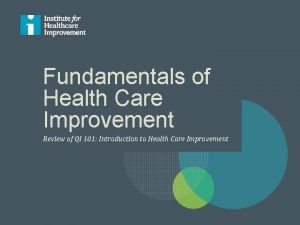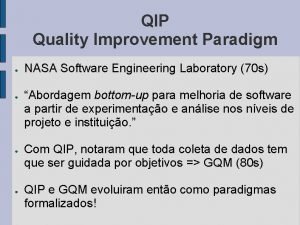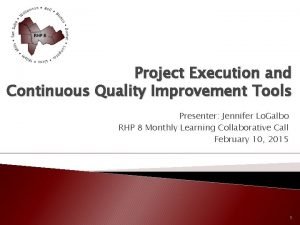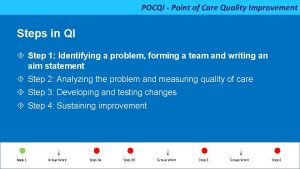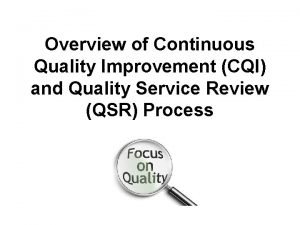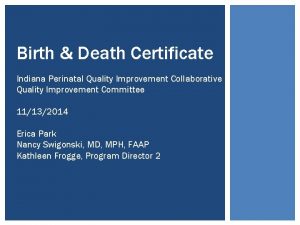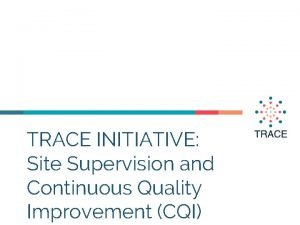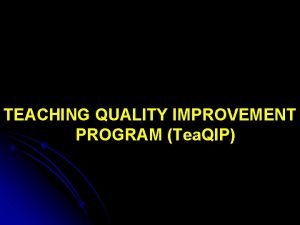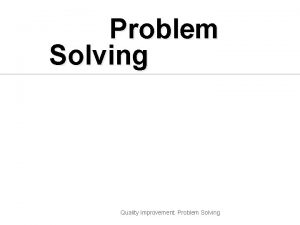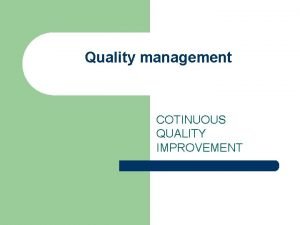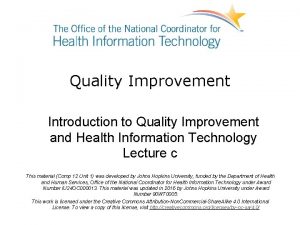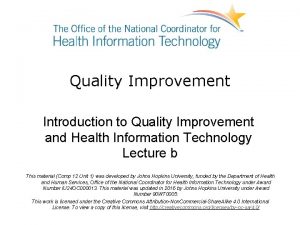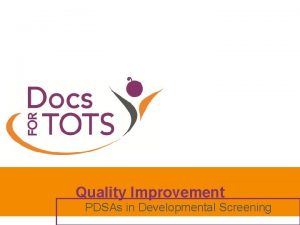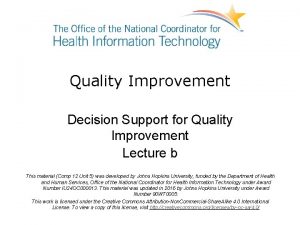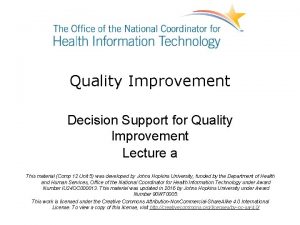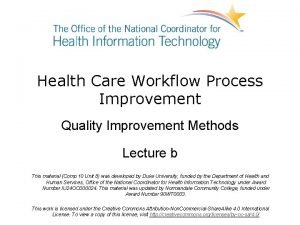Quality Improvement Introduction to Quality Improvement and Health

















- Slides: 17

Quality Improvement Introduction to Quality Improvement and Health Information Technology Lecture d This material (Comp 12 Unit 1) was developed by Johns Hopkins University, funded by the Department of Health and Human Services, Office of the National Coordinator for Health Information Technology under Award Number IU 24 OC 000013. This material was updated in 2016 by Johns Hopkins University under Award Number 90 WT 0005. This work is licensed under the Creative Commons Attribution-Non. Commercial-Share. Alike 4. 0 International License. To view a copy of this license, visit http: //creativecommons. org/licenses/by-nc-sa/4. 0/

Introduction to Quality Improvement and Health Information Technology Learning Objective — Lecture d • Analyze the ways that HIT can either help or hinder quality and patient safety. 2

Enhancing Equity with HIT Data capture Multi-modal functionality • Can monitor by population characteristics. • Can uncover health care disparities. • Can provide various ways for patients to get health information. • Can decrease health care disparity. Tailor to patient needs Decision support • Can enable competencybased patient education. • Can tailor information to educational background and development status. • Can provide drug cost information. • Can assist providers in selecting alternatives for low -income patients. 3

Equity: Case Review Event: • One of the greatest challenges to chronic care management in a public housing community is keeping patients engaged in their care. • They are often lost to follow-up care when they do not return for medical visits or refill their prescriptions. • This is especially problematic for vulnerable patients with diabetes. 4

What They Did: Self-Management Counseling System change: • Community volunteers were provided online training on self-management counseling for patients with diabetes. • They created a diabetes registry in the electronic health record to identify and recall patients due for routine diabetes care. • Just prior to the scheduled visit, the community volunteer reminds the patient of the visit and asks him to arrive early for self-management teaching. 5

HIT and Optimizing Equity • There are few stroke specialists in rural areas, so people at risk for stroke in these areas have unequal access to quality care. • Physicians in Arizona set up a hub-andspoke service using telemedicine (audiovideo) to decrease health disparities. (hub=urban stroke center; spoke=outlying rural hospitals) 6

Systematic Reviews of Health IT’s Impact on Quality and Safety Source: Banger, A. , & Graber, M. (2015 February). Recent evidence that health IT improves patient safety (Issue Brief). Retrieved March 28, 2016, from the U. S. Department of Health and Human Services, Office of the National Coordinator Web site: https: //www. healthit. gov/sites/default/files/brief_1_final_feb 11 t. pdf 7

Workarounds • Defined • Examples – Alternative processes – Nurses taking verbal that help workers avoid demands placed on them that they perceive to be unrealistic or harmful. – Unanticipated behaviors directly or indirectly caused by the EHR when the system impedes one’s work. orders rather than prescribers entering the order into CPOE due to workflow timing of event. – Significant events located in multiple locations in the EHR due to lack of standardization of data entry screens. 8

Artifacts • Defined • Examples – Manmade tools that – Bedside references. aid or enhance the worker’s thinking abilities. – Developed to meet the demands of an activity. – Patient locator boards. – Report sheets. – Documenting on paper then transcribing into electronic record. 9

HIT and Workarounds — 1 • Dr. Foxwood creates a new order each time he wants to re-order a medication. • The nurse enters a verbal order to discontinue the previous medication order, so that the medication will be removed from the electronic medication record. • Dr. Foxwood fails to co-sign the discontinuation order because he sees this as an administrative task. 10

HIT and Workarounds — 2 • When a barcoding medication system interfered with their workflow, nurses devised workarounds, such as removing the armband from the patient and attaching it to the bed because the barcode reader failed to interpret bar codes when the bracelet curved tightly around a small arm. Image courtesy U. S. Navy, Photo by Petty Officer 1 st Class Brian A. Goyak. 11

HIT and Workarounds — 3 • Investigators found increased mortality among children admitted to Children’s Hospital in Pittsburgh after CPOE implementation. • Three reasons were cited for this unexpected outcome: 1. CPOE changed the workflow. 2. Order entry required as many as 10 clicks and took as long as two minutes. 3. When the team changed its workflow to accommodate CPOE, faceto-face contact among team members diminished. 12

HIT Safety Tools Source: https: //www. healthit. gov/safer/ 13

Introduction to Quality Improvement and Health Information Technology Summary — Lecture d • Well-crafted HIT solutions can: – Improve safety, effectiveness, efficiency, equity, timeliness, and patient-centeredness of care. – Work to accomplish the best care for the whole population at the lowest cost. • Unintended consequences of HIT: – Can lower quality and result in unsafe care. – Can be minimized through best practices and avoidance of workarounds. – Need to be studied further. 14

Introduction to Quality Improvement and Health Information Technology References — Lecture d — 1 References Banger, A. , & Graber, M. (2015 February). Recent evidence that health IT improves patient safety (Issue Brief). Retrieved March 28, 2016, from the U. S. Department of Health and Human Services, Office of the National Coordinator Web site: https: //www. healthit. gov/sites/default/files/brief_1_final_feb 11 t. pdf Doyle, M. (2005). Impact of the Bar Code Medication Administration (BCMA) system on medication administration errors. Unpublished doctoral dissertation, University of Arizona, Tucson, in Nursing Informatics and the Foundation of Knowledge. Sudbury, MA: Jones and Bartlett Publishers. Han, Y. Y. , Carcillo, J. A. , Venkataraman, S. T. , et al. (2005). Unexpected increased mortality after implementation of a commercially sold computerized physician order entry system. Pediatrics. 116; 1506 – 1512. Images Slide 7: Systematic reviews of health IT’s impact on quality and safety. Banger, A. , & Graber, M. (2015 February). Recent evidence that health IT improves patient safety (Issue Brief). Retrieved March 28, 2016, from the U. S. Department of Health and Human Services, Office of the National Coordinator Web site: https: //www. healthit. gov/sites/default/files/brief_1_final_feb 11 t. pdf 15

Introduction to Quality Improvement and Health Information Technology References — Lecture d — 2 Images Slide 11: Patient armbands. Department of Defense. Retrieved March 24, 2016, from: http: //archive. defense. gov/dodcmsshare/homepagephoto/2011 -05/hires_110502 -NQD 416 -033 d. jpg Slide 13: SAFER guides. U. S. Department of Health and Human Services, Office of the National Coordinator. Retrieved March 24, 2016, from: https: //www. healthit. gov/safer/ 16

Quality Improvement Introduction to Quality Improvement and Health Information Technology Lecture d This material (Comp 12 Unit 1) was developed by Johns Hopkins University, funded by the Department of Health and Human Services, Office of the National Coordinator for Health Information Technology under Award Number IU 24 OC 000013. This material was updated in 2016 by Johns Hopkins University under Award Number 90 WT 0005. 17
 Process of nursing audit
Process of nursing audit Compliance vs quality
Compliance vs quality Qi 101: introduction to health care improvement
Qi 101: introduction to health care improvement Jhm irb
Jhm irb Qsen patient-centered care examples
Qsen patient-centered care examples Quality improvement paradigm
Quality improvement paradigm Continuous quality improvement plan example
Continuous quality improvement plan example Point of care quality improvement
Point of care quality improvement Define continuous quality improvement
Define continuous quality improvement Efmd quality improvement system
Efmd quality improvement system Indiana perinatal quality improvement collaborative
Indiana perinatal quality improvement collaborative Continuous quality improvement program planning worksheet
Continuous quality improvement program planning worksheet Tea quality improvement
Tea quality improvement Xerox problem solving process
Xerox problem solving process Sustainability in quality improvement
Sustainability in quality improvement Cotinuous
Cotinuous Quality improvement
Quality improvement Juran 10 steps to quality improvement
Juran 10 steps to quality improvement


